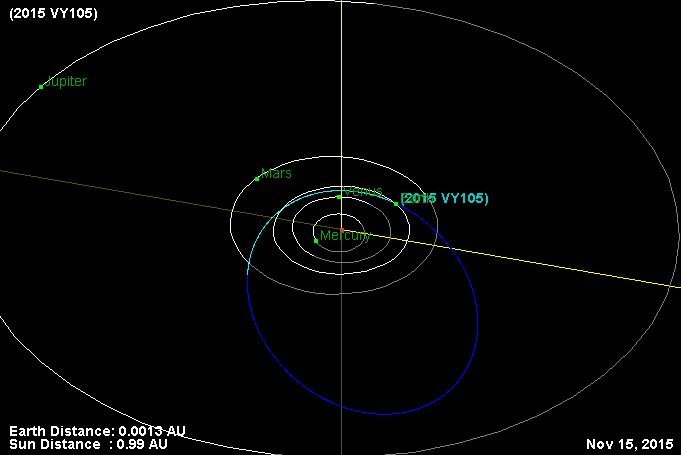Small asteroid makes a close Earth flyby at 0.09 LD

A small asteroid discovered on November 14, 2015, made a close flyby to Earth only a couple of hours after it was observed. The asteroid named 2015 VY105 came as close to our planet as an average geostationary satellite. However, good news is that 2015 VY105 was so small it would not have caused any damage had it fallen on Earth.
After this year's Halloween asteroid 2015 TB145, another small body has been discovered to approach our planet. It has traveled to a much closer distance than the 'spooky' rock, however, it is much smaller, and as such posed no threat, even though it was discovered only a few hours prior to the flyby.

Asteroid 2015 VY105 orbit on November 15, 2015. Image credit: NASA JPL
The rocky asteroid was discovered on November 14 by the Catalina Sky Survey and International Astronomical Union's Minor Planet Center has classified it as an Apollo type object, that is, an asteroid class known to occasionally cross paths with Earth.
2015 VY105 made its closest approach, at a distance of only 0.09 lunar distance (34 000 km or 21 000 miles) from our planet, on November 15 at 02:47 UTC. Its relative speed was approximately 17.42 km/s or 62 712 km/h (10.8 mps or 38 967 mph), according to NASA's Near Earth Object (NEO) Program. This distance is comparable to that of telecommunication satellites orbiting Earth, as they are located approximately 36 000 km (22 300 miles) above its surface.
The object's size has been estimated to range between 4.1 and 9.2 m (13.5 and 30.2 feet) which makes it small enough to pose no threat in case of falling on Earth. Had it actually entered our atmosphere, its largest part would most likely dissipate because of the air friction, which would provide quite a spectacular view.
Featured image: Rocky asteroid's close approach to Earth, Artist's impression. Image credit: NASA

These Near Earth Objects must be fascinating for astronomers but for people like me they are a reminder of just how vulnerable and unprepared we are. The fact that this NEO came so close before it was detected does not inspire confidence in our ability to avert catastrophe before it happens. Perhaps by further study we will learn more about precisely how many NEO’s there are, where they are located in relation to Earth, and what their trajectories are.